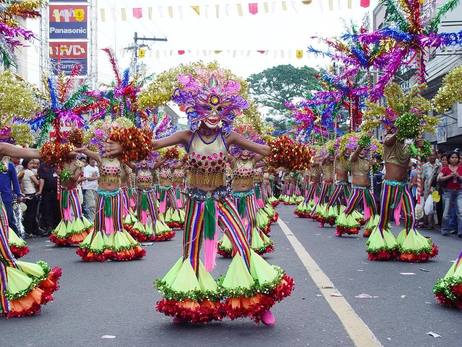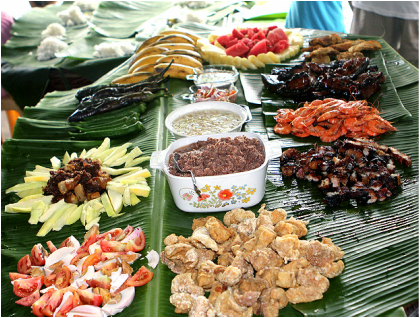ALL ABOUT THE PHILIPPINES
History | Cultures, Values, Food | Tourism, Hospitality
The Philippines are divided into three island groups: Luzon, Visayas, and Mindanao. These are divided into 18 regions, 81 provinces, 144 cities, 1,490 municipalities, and 42,029 barangays. A barangay captain is elected. The average barangay is approximately 2400 people.
 Ati-atihan Festival (Kalibo, Aklan, Philippines) is the wildest among Philippine fiestas and considered as the Mother of All Philippine festivals. Catholics and non-Catholics alike observe this special day. It’s celebrated annually every third week of January to honor the feast of the Holy Infant Jesus. Ati-atihan Festival (Kalibo, Aklan, Philippines) is the wildest among Philippine fiestas and considered as the Mother of All Philippine festivals. Catholics and non-Catholics alike observe this special day. It’s celebrated annually every third week of January to honor the feast of the Holy Infant Jesus.
The Philippines, officially known as the Republic of the Philippines is a sovereign island country in Southeast Asia situated in the western Pacific Ocean. It consists of 7,107 islands that are categorized broadly under three main geographical divisions: Luzon, Visayas, and Mindanao. The capital city of the Philippines is Manila and the most populous city is Quezon City; both are part of Metro Manila.
CULTURE Philippine culture is a combination of Eastern and Western cultures. The Philippines exhibits aspects found in other Asian countries with a Malay heritage, yet its culture also displays a significant amount of Spanish and American influences. Traditional festivities known as barrio fiestas (district festivals) to commemorate the feast days of patron saints are common. These community celebrations are times for feasting, music, and dancing. By comparison to Mardi Gras's they are tame LANGUAGE Filipino and English are the official languages of the country. Filipino is a standardized version of Tagalog, spoken mainly in Metro Manila and other urban regions. Both Filipino and English are used in government, education, print, broadcast media, and business. But regional languages exist and many Filipino's do not speak English at all nor Filipino (Tagalog). It is possible though to travel and communicate throughout the country (less some very remote regions) in English although though many are taught English in schools it is not used and conversations can be difficult. Keeping it simple, speaking slowly or writing it down in English help when communicating. 
VALUES
Filipino values are, for the most part, centered around maintaining social harmony, motivated primarily by the desire to be accepted within a group and the "family". The main sanction against diverging from these values are the concepts of "Hiya", roughly translated as 'a sense of shame', and "Amor propio" or 'self-esteem'. Social approval, acceptance by a group and having multiple friend relationships, are major concerns. Caring about what others will think, say or do, are strong influences on social behavior among Filipinos. This is a much stronger influence in general than the church and even within some families. Within the family female children, more often than not, are the caregivers and supporters of their parents as their parents age. It is expected and the ties between female children and parents are particularly strong in general. "Family" is security. Another element of the Filipino value system are an abhorrence of acts of cheating and thievery and criminals in general but a lot crime goes unreported out of fear of retribution. With materialism now a very distinct part of the culture coupled with low wages, poverty outside the cities and "single mothers" Internet fraud (on dating websites) is very common. A simple rule to follow is do not send money no matter what is told to you. |
FOOD
Philippine cuisine has evolved over several centuries to become a mixed cuisine with many Hispanic, Chinese, American, and other Asian influences adapted to local ingredients and the Filipino palate. The great majority of small restaurants you will see everywhere typically serve "local" food and although distinctive diversity is lacking it's generally good although beef and pork dishes can be very tough by western standards. The "local" food mentioned above is what would be prepared in the home. But among the poor (and this constitutes a large percentage of the population) rice, a vegetable and perhaps a very small amount of meat (typically fish) would be a typical meal. Bear in mind that outside the cities, with the exception of some large farms, many people are subsistence farmers (and fishermen). There are fast food restaurants and the malls have numerous restaurants as well in the cities. Hotels in outlying areas typically will have western food on the menu. Note: Some areas of the Philippines have hot and spicy food but in general it is relatively bland for those with world traveled taste-buds. HOSPITALITY Although not the only people in the world who are typically friendly and welcoming, even the humblest home along the road can serve as a shelter for a stranger who has lost his way or provide shelter from a storm. In most countries if not invited to a meal but arriving at at a friend's house during mealtime it is usually an awkward situation. In a Filipino house in contrast, you will be asked to sit down and share what they have on the table. To do otherwise would be considered rude. PERSONAL SAFETY While terrorists exist the number of people kidnapped is very few (although played up in the media extensively) and almost always in a very specific area outside the normal tourist flow. On a comparative basis the United States or Europe have more terrorists acts (and deaths) than the Philippines on a per capita basis. In terms of public safety you are far safer (with the possible exception of some areas in the larger cites) in the Philippines than you would be in Chicago, Paris or London. 4 million people plus visit the Philippines annually and tourism continues to grow significantly annually. Staying away from known areas in major cities where there is crime as well as watching your personal possessions constantly is necessary. 
TOURISM
The country's rich biodiversity is the main tourist attraction of the Philippines. Its beaches, mountains, rain-forests, islands and diving spots are among the country's most popular tourist destinations. The country's rich historical and cultural heritage is also one of the attractions of the Philippines. The Philippines' rain-forests and its extensive coastlines make it home to a diverse range of birds, plants, animals, and sea creatures. It is one of the ten most biologically mega diverse countries. Around 1,100 land vertebrate species can be found in the Philippines including over 100 mammal species and 170 bird species not thought to exist elsewhere. The Philippines has among the highest rates of discovery in the world with sixteen new species of mammals discovered in the last ten years. At the same time increasing population pressure and industry is putting significant strain on the Eco-system. |



